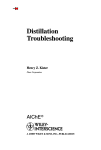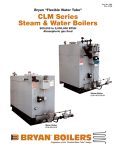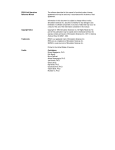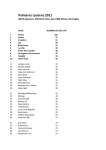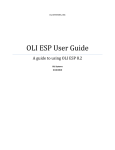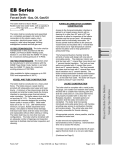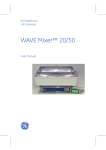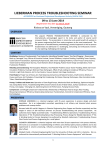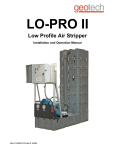Download Distillation Troubleshooting
Transcript
Distillation Troubleshooting Henry Z. Kister Fluor Corporation AlChE ® iWILEYINTERSCIENCE A JOHN WILEY & SONS, INC., PUBLICATION This page intentionally left blank Distillation Troubleshooting This page intentionally left blank Distillation Troubleshooting Henry Z. Kister Fluor Corporation AlChE ® iWILEYINTERSCIENCE A JOHN WILEY & SONS, INC., PUBLICATION DISCLAIMER The author and contributors to "Distillation Troubleshooting" do not represent, warrant, or otherwise guarantee, expressly or impliedly, that following the ideas, information, and recommendations outlined in this book will improve tower design, operation, downtime, troubleshooting, or the suitability, accuracy, reliability or completeness of the information or case histories contained herein. The users of the ideas, the information, and the recommendations contained in this book apply them at their own election and at their own risk. The author and the contributors to this book each expressly disclaims liability for any loss, damage or injury suffered or incurred as a result of or related to anyone using or relying on any of the ideas or recommendations in this book. The information and recommended practices included in this book are not intended to replace individual company standards or sound judgment in any circumstances. The information and recommendations in this book are offered as lessons from the past to be considered for the development of individual company standards and procedures. Copyright ©2006 by John Wiley & Sons, Inc. All rights reserved. Published by John Wiley & Sons, Inc., Hoboken, New Jersey. Published simultaneously in Canada. No part of this publication may be reproduced, stored in a retrieval system, or transmitted in any form or by any means, electronic, mechanical, photocopying, recording, scanning, or otherwise, except as permitted under Section 107 or 108 of the 1976 United States Copyright Act, without either the prior written permission of the Publisher, or authorization through payment of the appropriate per-copy fee to the Copyright Clearance Center, Inc., 222 Rosewood Drive, Danvers, MA 01923, 978-750-8400, fax 978-646-8600, or on the web at www.copyright.com. Requests to the Publisher for permission should be addressed to the Permissions Department, John Wiley & Sons, Inc., 111 River Street, Hoboken, NJ 07030, (201) 748-6011, fax (201) 748-6008, or online at www.wiley.com/go/permission. Limit of Liability/Disclaimer of Warranty: While the publisher and author have used their best efforts in preparing this book, they make no representations or warranties with respect to the accuracy or completeness of the contents of this book and specifically disclaim any implied warranties of merchantability orfitness for a particular purpose. No warranty may be created or extended by sales representatives or written sales materials. The advice and strategies contained herein may not be suitable for your situation. You should consult with a professional where appropriate. Neither the publisher nor author shall be liable for any loss of profit or any other commercial damages, including but not limited to special, incidental, consequential, or other damages. For general information on our other products and services please contact our Customer Care Department within the U.S. at 800-762-2974, outside the U.S. at 317-572-3993 or fax 317-572-4002. Wiley also publishes its books in a variety of electronic formats. Some content that appears in print, may not be available in electronic format. For more information about Wiley products, visit out web site at www.wiley.com. Library of Congress Cataloging-in-Publication Data: Kister, Henry Z. Distillation troubleshooting / Henry Z. Kister. p. cm. Includes bibliographical references. ISBN-13 978-0-0471-46744-1 (Cloth) ISBN-10 0-471-46744-8 (Cloth) 1. Distillation apparatus—Maintenance and repair. I. Title. TP159.D9K57 2005 660'.28425—dc22 2004016490 Printed in the United States of America 10 9 8 7 6 5 To my son, Abraham and my wife, Susana, who have been my love, inspiration, and the lighthouses illuminating my path, and to my life-long mentor, Dr. Walter Stupin - it is easy to rise when carried on the shoulders of giants. This page intentionally left blank Contents Preface xxiii Acknowledgments xxvii How to Use this Book Abbreviations xxix xxxi 1. Troubleshooting Distillation Simulations 1 2. Where Fractionation Goes Wrong 25 3. Energy Savings and Thermal Effects 61 4. Tower Sizing and Material Selection Affect Performance 73 5. Feed Entry Pitfalls in Tray Towers 97 6. Packed-Tower Liquid Distributors: Number 6 on the Top 10 Malfunctions 111 7. Vapor Maldistribution in Trays and Packings 133 8. Tower Base Level and Reboiler Return: Number 2 on the Top 10 Malfunctions 145 9. Chimney Tray Malfunctions: Part of Number 7 on the Top 10 Malfunctions 163 10. Draw-Off Malfunctions (Non-Chimney Tray) Part of Number 7 on the Top 10 Malfunctions 179 vii viii Contents 11. Tower Assembly Mishaps: Number 5 on the Top 10 Malfunctions 193 12. Difficulties During Start-Up, Shutdown, Commissioning, and Abnormal Operation: Number 4 on the Top 10 Malfunctions 215 13. Water-Induced Pressure Surges: Part of Number 3 on the Top 10 Malfunctions 225 14. Explosions, Fires, and Chemical Releases: Number 10 on the Top 10 Malfunctions 233 15. Undesired Reactions in Towers 237 16. Foaming 241 17. The Tower as a Filter: Part A. Causes of Plugging—Number 1 on the Top 10 Malfunctions 253 18. The Tower as a Filter: Part B. Location of Plugging—Number 1 on the Top 10 Malfunctions 257 19. Coking: Number 1 on the Top 10 Malfunctions 271 20. Leaks 281 21. Relief and Failure 287 22. Tray, Packing, and Tower Damage: Part of Number 3 on the Top 10 Malfunctions 291 23. Reboilers That Did Not Work: Number 9 on the Top 10 Malfunctions 315 24. Condensers That Did Not Work 335 25. Misleading Measurements: Number 8 on the Top 10 Malfunctions 347 Contents ix 26. Control System Assembly Difficulties 357 27. Where Do Temperature and Composition Controls Go Wrong? 373 28. Misbehaved Pressure, Condenser, Reboiler, and Preheater Controls 377 29. Miscellaneous Control Problems 395 DISTILLATION TROUBLESHOOTING DATABASE OF PUBLISHED CASE HISTORIES 1. Troubleshooting Distillation Simulations 1.1 VLE 1.1.1 1.1.2 1.1.3 1.1.4 1.1.5 1.1.6 1.2 1.3 1.4 1.5 1.6 398 Close-Boiling Systems 398 Nonideal Systems 399 Nonideality Predicted in Ideal System 400 Nonideal VLE Extrapolated to Pure Products 400 Nonideal VLE Extrapolated to Different Pressures 401 Incorrect Accounting for Association Gives Wild Predictions 401 1.1.7 Poor Characterization of Petroleum Fractions 402 Chemistry, Process Sequence 402 Does Your Distillation Simulation Reflect the Real World? 404 1.3.1 General 404 1.3.2 With Second Liquid Phase 406 1.3.3 Refinery Vacuum Tower Wash Sections 406 1.3.4 Modeling Tower Feed 406 1.3.5 Simulation/Plant Data Mismatch Can Be Due to an Unexpected Internal Leak 406 1.3.6 Simulation/Plant Data Mismatch Can Be Due to Liquid Entrainment in Vapor Draw 407 1.3.7 Bug in Simulation 407 Graphical Techniques to Troubleshoot Simulations 407 1.4.1 McCabe-Thiele and Hengstebeck Diagrams 407 1.4.2 Multicomponent Composition Profiles 407 1.4.3 Residue Curve Maps 407 How Good Is Your Efficiency Estimate? 407 Simulator Hydraulic Predictions: To Trust or Not to Trust 409 1.6.1 Do Your Vapor and Liquid Loadings Correctly Reflect Subcool, Superheat, and Pumparounds? 409 1.6.2 How Good Are the Simulation Hydraulic Prediction Correlations? 409 398 Contents 2. Where Fractionation Goes Wrong 2.1 2.2 2.3 2.4 2.5 2.6 410 Insufficient Reflux or Stages; Pinches 410 No Stripping in Stripper 412 Unique Features of Multicomponent Distillation 412 Accumulation and Hiccups 413 2.4.1 Intermediate Component, No Hiccups 413 2.4.2 Intermediate Component, with Hiccups 414 2.4.3 Lights Accumulation 416 2.4.4 Accumulation between Feed and Top or Feed and Bottom 417 2.4.5 Accumulation by Recycling 418 2.4.6 Hydrates, Freeze-Ups 418 Two Liquid Phases 419 Azeotropic and Extractive Distillation 421 2.6.1 Problems Unique to Azeotroping 421 2.6.2 Problems Unique to Extractive Distillation 423 3. Energy Savings and Thermal Effects 3.1 Energy-Saving Designs and Operation 424 3.1.1 Excess Preheat and Precool 424 3.1.2 Side-Reboiler Problems 424 3.1.3 Bypassing a Feed around the Tower 424 3.1.4 Reducing Recycle 425 3.1.5 Heat Integration Imbalances 426 3.2 Subcooling: How It Impacts Towers 428 3.2.1 Additional Internal Condensation and Reflux 3.2.2 Less Loadings above Feed 429 3.2.3 Trapping Lights and Quenching 429 3.2.4 Others 430 3.3 Superheat: How It Impacts Towers 430 424 428 4. Tower Sizing and Material Selection Affect Performance 4.1 4.2 4.3 4.4 4.5 4.6 4.7 4.8 Undersizing Trays and Downcomers 431 Oversizing Trays 431 Tray Details Can Bottleneck Towers 433 Low Liquid Loads Can Be Troublesome 434 4.4.1 Loss of Downcomer Seal 434 4.4.2 Tray Dryout 435 Special Bubble-Cap Tray Problems 436 Misting 437 Undersizing Packings 437 Systems Where Packings Perform Different from Expectations 431 437 Contents 4.9 4.10 4.11 4.12 4.13 Packed Bed Too Long 438 Packing Supports Can Bottleneck Towers 439 Packing Hold-downs Are Sometimes Troublesome Internals Unique to Packed Towers 440 Empty (Spray) Sections 440 440 5. Feed Entry Pitfalls in Tray Towers 5.1 5.2 5.3 5.4 5.5 Does the Feed Enter the Correct Tray? 441 Feed Pipes Obstructing Downcomer Entrance 441 Feed Flash Can Choke Downcomers 441 Subcooled Feeds, Refluxes Are Not Always Trouble Free Liquid and Unsuitable Distributors Do Not Work with Flashing Feeds 442 5.6 Flashing Feeds Require More Space 443 5.7 Uneven or Restrictive Liquid Split to Multipass Trays at Feeds and Pass Transitions 443 5.8 Oversized Feed Pipes 444 5.9 Plugged Distributor Holes 444 5.10 Low Δ Ρ Trays Require Decent Distribution 445 441 442 6. Packed-Tower Liquid Distributors: Number 6 on the Top 10 Malfunctions 6.1 6.2 6.3 6.4 6.5 6.6 6.7 6.8 6.9 6.10 6.11 6.12 6.13 xi Better Quality Distributors Improve Performance 446 6.1.1 Original Distributor Orifice or Unspecified 446 6.1.2 Original Distributor Weir Type 447 6.1.3 Original Distributor Spray Type 447 Plugged Distributors Do Not Distribute Well 448 6.2.1 Pan/Trough Orifice Distributors 448 6.2.2 Pipe Orifice Distributors 449 6.2.3 Spray Distributors 450 Overflow in Gravity Distributors: Death to Distribution 451 Feed Pipe Entry and Predistributor Problems 454 Poor Hashing Feed Entry Bottleneck Towers 455 Oversized Weep Holes Generate Undesirable Distribution 456 Damaged Distributors Do Not Distribute Well 457 6.7.1 Broken Flanges or Missing Spray Nozzles 457 6.7.2 Others 457 Hole Pattern and Liquid Heads Determine Irrigation Quality 458 Gravity Distributors Are Meant to Be Level 459 Hold-Down Can Interfere with Distribution 460 Liquid Mixing Is Needed in Large-Diameter Distributors 460 Notched Distributors Have Unique Problems 461 Others 461 446 xii Contents 7. Vapor Maldistribution in ΊΥ-ays and Packings 462 7.1 Vapor Feed/Reboiler Return Maldistributes Vapor to Packing Above 462 7.1.1 Chemical/Gas Plant Packed Towers 462 7.1.2 Packed Refinery Main Fractionators 463 7.2 Experiences with Vapor Inlet Distribution Baffles 465 7.3 Packing Vapor Maldistribution at Intermediate Feeds and Chimney Trays 465 7.4 Vapor Maldistribution Is Detrimental in Tray Towers 466 7.4.1 Vapor Cross-Flow Channeling 466 7.4.2 Multipass Trays 467 7.4.3 Others 467 8. Tower Base Level and Reboiler Return: Number 2 on the Top 10 Malfunctions 468 8.1 Causes of High Base Level 468 8.1.1 Faulty Level Measurement or Level Control 468 8.1.2 Operation 469 8.1.3 Excess Reboiler Pressure Drop 470 8.1.4 Undersized Bottom Draw Nozzle or Bottom Line 470 8.1.5 Others 470 8.2 High Base Level Causes Premature Tower Flood (No Tray/Packing Damage) 470 8.3 High Base Liquid Level Causes Tray/Packing Damage 471 8.4 Impingement by the Reboiler Return Inlet 472 8.4.1 On Liquid Level 472 8.4.2 On Instruments 473 8.4.3 On Tower Wall 473 8.4.4 Opposing Reboiler Return Lines 474 8.4.5 On Trays 474 8.4.6 On Seal Pan Overflow 474 8.5 Undersized Bottom Feed Line 475 8.6 Low Base Liquid Level 475 8.7 Issues with Tower Base Baffles 476 8.8 Vortexing 476 9. Chimney Tray Malfunctions: Part of Number 7 on the Top 10 Malfunctions 9.1 9.2 9.3 9.4 Leakage 477 Problem with Liquid Removal, Downcomers, or Overflows 478 Thermal Expansion Causing Warping, Out-of-Levelness 479 Chimneys Impeding Liquid Flow to Outlet 480 477 Contents 9.5 Vapor from Chimneys Interfering with Incoming Liquid 9.6 Level Measurement Problems 481 9.7 Coking, Fouling, Freezing 482 9.8 Other Chimney Tray Issues 482 480 10. Drawoff Malfunctions (Non-Chimney Tray): Part of Number 7 on the Top 10 Malfunctions 10.1 10.2 10.3 10.4 10.5 10.6 10.7 10.8 10.9 Vapor Chokes Liquid Draw Lines 484 10.1.1 Insufficient Degassing 484 10.1.2 Excess Line Pressure Drop 485 10.1.3 Vortexing 486 Leak at Draw Tray Starves Draw 486 Draw Pans and Draw Lines Plug Up 488 Draw Tray Damage Affects Draw Rates 488 Undersized Side-Stripper Overhead Lines Restrict Draw Rates Degassed Draw Pan Liquid Initiates Downcomer Backup Flood Other Problems with Tower Liquid Draws 489 Liquid Entrainment in Vapor Side Draws 490 Reflux Drum Malfunctions 490 10.9.1 Reflux Drum Level Problems 490 10.9.2 Undersized or Plugged Product Lines 490 10.9.3 Two Liquid Phases 490 11. Tower Assembly Mishaps: Number 5 on the Top 10 Malfunctions 11.1 11.2 11.3 11.4 11.5 11.6 11.7 11.8 11.9 11.10 11.11 11.12 11.13 xiii Incorrect Tray Assembly 491 Downcomer Clearance and Inlet Weir Malinstallation 491 Flow Passage Obstruction and Internals Misorientation at Tray Tower Feeds and Draws 492 Leaking Trays and Accumulator Trays 493 Bolts, Nuts, Clamps 493 Manways/Hatchways Left Unbolted 493 Materials of Construction Inferior to Those Specified 494 Debris Left in Tower or Piping 494 Packing Assembly Mishaps 495 11.9.1 Random 495 11.9.2 Structured 496 11.9.3 Grid 496 Fabrication and Installation Mishaps in Packing Distributors Parts Not Fitting through Manholes 498 Auxiliary Heat Exchanger Fabrication and Assembly Mishaps Auxiliary Piping Assembly Mishaps 498 484 488 489 491 496 498 xiv Contents 12. Difficulties during Start-Up, Shutdown, Commissioning, and Abnormal Operation: Number 4 on the Top 10 Malfunctions 12.1 12.2 12.3 12.4 12.5 12.6 12.7 12.8 12.9 12.10 12.11 12.12 Blinding/Unblinding Lines 499 Backflow 500 Dead-Pocket Accumulation and Release of Trapped Materials Purging 501 Pressuring and Depressuring 502 Washing 502 On-Line Washes 504 Steam and Water Operations 506 Overheating 506 Cooling 507 Overchilling 507 Water Removal 508 12.12.1 Draining at Low Points 508 12.12.2 Oil Circulation 508 12.12.3 Condensation of Steam Purges 508 12.12.4 Dehydration by Other Procedures 508 12.13 Start-Up and Initial Operation 509 12.13.1 Total-Reflux Operation 509 12.13.2 Adding Components That Smooth Start-Up 509 12.13.3 Siphoning 509 12.13.4 Pressure Control at Start-Up 510 12.14 Confined Space and Manhole Hazards 510 499 501 13. Water-Induced Pressure Surges: Part of Number 3 on the Top 10 Malfunctions 13.1 13.2 13.3 13.4 13.5 13.6 13.7 Water in Feed and Slop 512 Accumulated Water in Transfer Line to Tower and in Heater Passes 513 Water Accumulation in Dead Pockets 513 Water Pockets in Pump or Spare Pump Lines 514 Undrained Stripping Steam Lines 515 Condensed Steam or Refluxed Water Reaching Hot Section Oil Entering Water-Filled Region 517 14. Explosions, Fires, and Chemical Releases: Number 10 on the Top 10 Malfunctions 14.1 Explosions Due to Decomposition Reactions 518 14.1.1 Ethylene Oxide Towers 518 14.1.2 Peroxide Towers 519 14.1.3 Nitro Compound Towers 520 14.1.4 Other Unstable-Chemical Towers 521 512 516 518 Contents 14.2 14.3 Explosions Due to Violent Reactions 523 Explosions and Fires Due to Line Fracture 524 14.3.1 C3-C4 Hydrocarbons 524 14.3.2 Overchilling 525 14.3.3 Water Freeze 526 14.3.4 Other 527 14.4 Explosions Due to Trapped Hydrocarbon or Chemical Release 14.5 Explosions Induced by Commissioning Operations 528 14.6 Packing Fires 529 14.6.1 Initiated by Hot Work Above Steel Packing 529 14.6.2 Pyrophoric Deposits Played a Major Role, Steel Packing 14.6.3 Tower Manholes Opened While Packing Hot, Steel Packing 532 14.6.4 Others, Steel Packing Fires 532 14.6.5 Titanium, Zinconium Packing Fires 533 14.7 Fires Due to Opening Tower before Cooling or Combustible Removal 533 14.8 Fires Caused by Backflow 534 14.9 Fires by Other Causes 535 14.10 Chemical Releases by Backflow 536 14.11 Trapped Chemicals Released 536 14.12 Relief, Venting, Draining, Blowdown to Atmosphere 537 15. Undesired Reactions in Towers 15.1 15.2 15.3 15.4 15.5 15.6 15.7 15.8 15.9 Excessive Bottom Temperature/Pressure 539 Hot Spots 539 Concentration or Entry of Reactive Chemical 539 Chemicals from Commissioning 540 Catalyst Fines, Rust, Tower Materials Promote Reaction Long Residence Times 541 Inhibitor Problems 541 Air Leaks Promote Tower Reactions 542 Impurity in Product Causes Reaction Downstream 542 16. Foaming 16.1 What Causes or Promotes Foaming? 543 16.1.1 Solids, Corrosion Products 543 16.1.2 Corrosion and Fouling Inhibitors, Additives, and Impurities 544 16.1.3 Hydrocarbon Condensation into Aqueous Solutions 16.1.4 Wrong Filter Elements 546 16.1.5 Rapid Pressure Reduction 546 16.1.6 Proximity to Solution Plait Point 546 527 530 539 540 543 545 xvi Contents 16.2 16.3 16.4 16.5 16.6 What Are Foams Sensitive To? 546 16.2.1 Feedstock 546 16.2.2 Temperature 547 16.2.3 Pressure 547 Laboratory Tests 547 16.3.1 Sample Shake, Air Bubbling 547 16.3.2 Oldershaw Column 547 16.3.3 Foam Test Apparatus 548 16.3.4 At Plant Conditions 548 Antifoam Injection 548 16.4.1 Effective Only at the Correct Quantity/Concentration 548 16.4.2 Some Antifoams Are More Effective Than Others 549 16.4.3 Batch Injection Often Works, But Continuous Can Be Better 549 16.4.4 Correct Dispersal Is Important, Too 550 16.4.5 Antifoam Is Sometimes Adsorbed on Carbon Beds 550 16.4.6 Other Successful Antifoam Experiences 550 16.4.7 Sometimes Antifoam Is Less Effective 551 System Cleanup Mitigates Foaming 551 16.5.1 Improving Filtration 551 16.5.2 Carbon Beds Mitigate Foaming But Can Adsorb Antifoam 553 16.5.3 Removing Hydrocarbons from Aqueous Solvents 553 16.5.4 Changing Absorber Solvent 553 16.5.5 Other Contaminant Removal Techniques 554 Hardware Changes Can Debottleneck Foaming Towers 555 16.6.1 Larger Downcomers 555 16.6.2 Smaller Downcomer Backup (Lower Pressure Drop, Larger Clearances) 556 16.6.3 More Tray Spacing 556 16.6.4 Removing Top Two Trays Does Not Help 556 16.6.5 Trays Versus Packings 556 16.6.6 Larger Packings, High-Open-Area Distributors Help 557 16.6.7 Increased Agitation 557 16.6.8 Larger Tower 557 16.6.9 Reducing Base Level 557 17. The Tower as a Filter: Part A. Causes of Plugging—Number 1 on the Top 10 Malfunctions 17.1 17.2 17.3 17.4 17.5 Piping Scale/Corrosion Products 558 Salting Out/Precipitation 559 Polymer/Reaction Products 560 Solids/Entrainment in the Feed 561 Oil Leak 561 558 Contents 17.6 Poor Shutdown Wash/Flush 562 17.7 Entrainment or Drying at Low Liquid Rates 17.8 Others 562 562 18. The Tower as a Filter: Part B. Locations of Plugging—Number 1 on the Top 10 Malfunctions 18.1 18.2 18.3 18.4 18.5 18.6 18.7 18.8 Trays 563 Downcomers 564 Packings 565 How Packings and Trays Compare on Plugging Resistance 18.4.1 Trays versus Trays 565 18.4.2 Trays versus Packings 566 18.4.3 Packings versus Packings 567 Limited Zone Only 567 Draw, Exchanger, and Vent Lines 569 Feed and Inlet Lines 570 Instrument Lines 570 563 565 19. Coking: Part of Number 1 on Tower Top 10 Malfunctions 19.1 19.2 19.3 19.4 19.5 xvii Insufficient Wash Flow Rate, Refinery Vacuum Towers Other Causes, Refinery Vacuum Towers 572 Slurry Section, FCC Fractionators 573 Other Refinery Fractionators 574 Nonrefinery Fractionators 574 571 571 20. Leaks 20.1 Pump, Compressor 575 20.2 Heat Exchanger 575 20.2.1 Reboiler Tube 575 20.2.2 Condenser Tube 576 20.2.3 Auxiliary Heat Exchanger (Preheater, Pumparound) 20.3 Chemicals to/from Other Equipment 577 20.3.1 Leaking from Tower 577 20.3.2 Leaking into Tower 577 20.3.3 Product to Product 578 20.4 Atmospheric 578 20.4.1 Chemicals to Atmosphere 578 20.4.2 Air into Tower 579 575 576 21. Relief and Failure 21.1 Relief Requirements 580 21.2 Controls That Affect Relief Requirements and Frequency 21.3 Relief Causes Tower Damage, Shifts Deposits 581 580 580 xviii Contents 21.4 21.5 21.6 21.7 21.8 21.9 21.10 21.11 Overpressure Due to Component Entry 581 Relief Protection Absent or Inadequate 582 Line Ruptures 583 All Indication Lost When Instrument Tap Plugged 584 Trips Not Activating or Incorrectly Set Pump Failure 585 Loss of Vacuum 585 Power Loss 585 22. Tray, Packing, and Tower Damage: Part of Number 3 on the Top 10 Malfunctions 22.1 22.2 22.3 22.4 22.5 22.6 22.7 22.8 22.9 22.10 22.11 22.12 22.13 22.14 22.15 586 Vacuum 586 Insufficient Uplift Resistance 587 Uplift Due to Poor Tightening during Assembly 587 Uplift Due to Rapid Upward Gas Surge 589 Valves Popping Out 590 Downward Force on Trays 590 Trays below Feed Bent Up, above Bent Down and Vice Versa Downcomers Compressed, Bowed, Fallen 592 Uplift of Cartridge Trays 593 Flow-Induced Vibrations 593 Compressor Surge 594 Packing Carryover 595 Melting, Breakage of Plastic Packing 595 Damage to Ceramic Packing 595 Damage to Other Packings 595 23. Reboilers That Did Not Work: Number 9 on the Top 10 Malfunctions 23.1 23.2 23.3 23.4 Circulating Thermosiphon Reboilers 596 23.1.1 Excess Circulation 596 23.1.2 Insufficient Circulation 596 23.1.3 Insufficient Δ Τ, Pinching 596 23.1.4 Surging 596 23.1.5 Velocities Too Low in Vertical Thermosiphons 23.1.6 Problems Unique to Horizontal Thermosiphons Once-Through Thermosiphon Reboilers 597 23.2.1 Leaking Draw Tray or Draw Pan 597 23.2.2 No Vaporization/Thermosiphon 598 23.2.3 Slug Flow in Outlet Line 599 Forced-Circulation Reboilers 599 Kettle Reboilers 599 23.4.1 Excess Δ Ρ in Circuit 599 23.4.2 Poor Liquid Spread 601 23.4.3 Liquid Level above Overflow Baffle 602 591 596 597 597 Contents xix 23.5 23.6 23.7 Internal Reboilers 602 Kettle and Thermosiphon Reboilers in Series 603 Side Reboilers 603 23.7.1 Inability to Start 603 23.7.2 Liquid Draw and Vapor Return Problems 603 23.7.3 Hydrates 603 23.7.4 Pinching 604 23.7.5 Control Issues 604 23.8 All Reboilers, Boiling Side 604 23.8.1 Debris/Deposits in Reboiler Lines 604 23.8.2 Undersizing 604 23.8.3 Film Boiling 604 23.9 All Reboilers, Condensing Side 605 23.9.1 Non condensables in Heating Medium 605 23.9.2 Loss of Condensate Seal 605 23.9.3 Condensate Draining Problems 606 23.9.4 Vapor/Steam Supply Bottleneck 606 24. Condensers That Did Not Work 607 24.1 Inerts Blanketing 607 24.1.1 Inadequate Venting 607 24.1.2 Excess Lights in Feed 608 24.2 Inadequate Condensate Removal 608 24.2.1 Undersized Condensate Lines 608 24.2.2 Exchanger Design 609 24.3 Unexpected Condensation Heat Curve 609 24.4 Problems with Condenser Hardware 610 24.5 Maldistribution between Parallel Condensers 611 24.6 Flooding/Entrainment in Partial Condensers 611 24.7 Interaction with Vacuum and Recompression Equipment 24.8 Others 612 612 25. Misleading Measurements: Number 8 on the Top 10 Malfunctions 25.1 25.2 25.3 25.4 25.5 Incorrect Readings 613 Meter or Taps Fouled or Plugged 614 Missing Meter 615 Incorrect Meter Location 615 Problems with Meter and Meter Tubing Installation 25.5.1 Incorrect Meter Installation 616 25.5.2 Instrument Tubing Problems 616 25.6 Incorrect Meter Calibration, Meter Factor 617 25.7 Level Instrument Fooled 617 25.7.1 By Froth or Foam 617 25.7.2 By Oil Accumulation above Aqueous Level 25.7.3 By Lights 619 616 618 613 xx Contents 25.7.4 By Radioactivity (Nucleonic Meter) 25.7.5 Interface-Level Metering Problems 25.8 Meter Readings Ignored 619 25.9 Electric Storm Causes Signal Failure 619 619 619 26. Control System Assembly Difficulties 26.1 No Material Balance Control 620 26.2 Controlling Two Temperatures/Compositions Simultaneously Produces Interaction 621 26.3 Problems with the Common Control Schemes, No Side Draws 26.3.1 Boil-Up on TC/AC, Reflux on FC 622 26.3.2 Boil-Up on FC, Reflux on TC/AC 623 26.3.3 Boil-Up on FC, Reflux on LC 624 26.3.4 Boil-Up on LC, Bottoms on TC/AC 625 26.3.5 Reflux on Base LC, Bottoms on TC/AC 626 26.4 Problems with Side-Draw Controls 626 26.4.1 Small Reflux below Liquid Draw Should Not Be on Level or Difference Control 626 26.4.2 Incomplete Material Balance Control with Liquid Draw 26.4.3 Steam Spikes with Liquid Draw 628 26.4.4 Internal Vapor Control makes or Breaks Vapor Draw Control 628 26.4.5 Others 628 27. Where Do Temperature and Composition Controls Go Wrong? 27.1 Temperature Control 629 27.1.1 No Good Temperature Control Tray 629 27.1.2 Best Control Tray 630 27.1.3 Fooling by Nonkeys 630 27.1.4 Averaging (Including Double Differential) 631 27.1.5 Azeotropic Distillation 631 27.1.6 Extractive Distillation 631 27.1.7 Other 632 27.2 Pressure-Compensated Temperature Controls 632 27.2.1 AT Control 632 27.2.2 Other Pressure Compensation 633 27.3 Analyzer Control 633 27.3.1 Obtaining a Valid Analysis for Control 633 27.3.2 Long Lags and High Off-Line Times 633 27.3.3 Intermittent Analysis 634 27.3.4 Handling Feed Fluctuations 635 27.3.5 Analyzer-Temperature Control Cascade 635 27.3.6 Analyzer On Next Tower 635 620 622 628 629 Contents 28. Misbehaved Pressure, Condenser, Reboiler, and Preheater Controls xxi 636 28.1 Pressure Controls by Vapor Flow Variations 636 28.2 Flooded Condenser Pressure Controls 637 28.2.1 Valve in the Condensate, Unflooded Drum 637 28.2.2 Flooded Drum 637 28.2.3 Hot-Vapor Bypass 637 28.2.4 Valve in the Vapor to the Condenser 639 28.3 Coolant Throttling Pressure Controls 640 28.3.1 Cooling-Water Throttling 640 28.3.2 Manipulating Airflow 640 28.3.3 Steam Generator Overhead Condenser 640 28.3.4 Controlling Cooling-Water Supply Temperature 640 28.4 Pressure Control Signal 641 28.4.1 From Tower or from Reflux Drum? 641 28.4.2 Controlling Pressure via Condensate Temperature 641 28.5 Throttling Steam/Vapor to Reboiler or Preheater 641 28.6 Throttling Condensate from Reboiler 642 28.7 Preheater Controls 643 29. Miscellaneous Control Problems 29.1 29.2 29.3 29.4 29.5 29.6 Interaction with the Process 644 A Ρ Control 644 Flood Controls and Indicators 644 Batch Distillation Control 645 Problems in the Control Engineer's Domain 645 Advanced Controls Problems 646 29.6.1 Updating Multivariable Controls 646 29.6.2 Advanced Controls Fooled by Bad Measurements 29.6.3 Issues with Model Inaccuracies 647 29.6.4 Effect of Power Dips 647 29.6.5 Experiences with Composition Predictors in Multivariable Controls 647 References Index 649 669 About the Author 713 644 646 This page intentionally left blank Preface "To every problem, there's always an easy solution—neat, plausible, and wrong." —Mencken's Maxim The last half-century has seen tremendous progress in distillation technology. The introduction of high-speed computers revolutionized the design, control, and operation of distillation towers. Invention and innovation in tower internals enhanced tower capacity and efficiency beyond previously conceived limits. Gamma scans and laser-guided pyrometers have provided troubleshooters with tools of which, not-solong-ago, they would only dream. With all these advances, one would expect the failure rate in distillation towers to be on the decline, maybe heading towards extinction as we enter the 21 st century. Our recent survey of distillation failures (255) brought disappointing news: Distillation failures are not on the path to extinction. Instead, the tower failure rate is on the rise and accelerating. Our survey further showed that the rise is not because distillation is moving into new, unchartered frontiers. By far, the bulk of the failures have been repetitions of previous ones. In some cases, the literature describes 10-20 repetitions of the same failure. And for every case that is reported, there are tens, maybe hundreds, that are not. In the late 1980s, I increased tray hole areas in one distillation tower in an attempt to gain capacity. Due to vapor cross flow channeling, a mechanism unknown at the time, the debottleneck went sour and we lost 5% capacity. Half a year of extensive troubleshooting, gamma scans, and tests taught us what went wrong and how to regain the lost capacity. We published extensively on the phenomenon and how to avoid. A decade later, I returned to investigate why another debottleneck (this time by others) went sour at the same unit. The tower I previously struggled with was replaced by a larger one, but the next tower in the sequence (almost the same hydraulics as the first) was debottlenecked... by increasing tray hole areas! It dawned on me how short a memory the process industries have. People move on, the lessons get forgotten, and the same mistakes are repeated. It took only one decade to forget. Indeed, people moved on: only one person (beside me) that experienced the 1980s debottleneck was involved in the 1990s efforts. This person actually questioned xxiii xxiv Preface the debottleneck proposal, but was overruled by those who did not believe it will happen again. Likewise, many experiences are repeatedly reported in the literature. Over the last two decades, there has been about one published case history per year of a tower flooding prematurely due to liquid level rising above the reboiler return nozzle, or of a kettle reboiler bottleneck due to an incorrectly compiled force balance. One would think that had we learned from the first case, all the repetitions could have been avoided. And again, for every case that is reported, there are tens, maybe hundreds that are not. Why are we failing to learn from past lessons? Mergers and cost-cuts have retired many of the experienced troubleshooters and thinly spread the others. The literature offers little to bridge the experience gap. In the era of information explosion, databases, and computerized searches, finding the appropriate information in due time has become likefinding a needle in an evergrowing haystack. To locate a useful reference, one needs to click away a huge volume of wayward leads. Further, cost-cutting measures led to library closures and to curtailed circulation and availability of some prime sources of information, such as, AIChE meeting papers. The purpose of this book is pick the needles out of the haystack. The book collects lessons from past experiences and puts them in the hands of troubleshooters in a usable form. The book is made up of two parts: thefirst is a collection of "war stories," with the detailed problems and solutions. The second part is a database mega-table which presents summaries of all the "war stories" I managed tofind in the literature. The summaries include some key distillation-related morals. For each of these, the literature reference is described fully, so readers can seek more details. Many of the case histories could be described under more than one heading, so extensive cross references have been included. If an incident that happened in your plant is described, you may notice that some details could have changed. Sometimes, this was done to make it more difficult for people to tell where the incident occurred. At other times, this was done to simplify the story without affecting the key lessons. Sometimes, the incident was written up several years after it occurred, and memories of some details faded away. Sometimes, and this is the most likely reason, the case history did not happen in your plant at all. Another plant had a similar incident. The case histories and lessons drawn are described to the best of my and the contributors' knowledge and in good faith, but do not always correctly reflect the problems and solutions. Many times I thought I knew the answer, possibly even solved the problem, only to be humbled by new light or another experience later. The experiences and lessons in the book are not meant to be followed blindly. They are meant to be taken as stories told in good faith, and to the best of knowledge and understanding of the author or contributor. We welcome any comments that either affirm or challenge our perception and understanding. If you picked the book, you expressed interest in learning from past experiences. This learning is an essential major step along the path traveled by a good troubleshooter or designer. Should you select this path, be prepared for many sleepless nights in the plant, endless worries as to whether you have the right answer, tests that will Preface xxv shatter your favorite theories, and many humbling experiences. Yet, you will share the glory when your fix or design solves a problem where others failed. You will enjoy harnessing the forces of nature into a beneficial purpose. Last but not least, you will experience the electric excitement of the "moments of insight," when all the facts you have been struggling with for months suddenly fall together into a simple explanation. I hope this book helps to get you there. HENRY Z . KISTER March 2006 This page intentionally left blank Acknowledgments Many of the case histories reported in this book have been invaluable contributions from colleagues and friends who kindly and enthusiastically supported this book. Many of the contributors elected to remain anonymous. Kind thanks are due to all contributors. Special thanks are due to those who contributed multiple case histories, and to those whose names do not appear in print. To those behind-the-scenes friends, I extends special appreciation and gratitude. Writing this book required breaking away from some of the everyday work demands. Special thanks are due to Fluor Corporation, particularly to my supervisors, Walter Stupin and Paul Walker, for their backing, support and encouragement of this book-writing effort, going to great lengths to make it happen. Recognition is due to my mentors who, over the years, encouraged my work, immensely contributed to my achievements, and taught me much about distillation and engineering: To my life-long mentor, Walter Stupin, who mentored and encouraged my work, throughout my career at C F Braun and later at Fluor, being a ceaseless source of inspiration behind my books and technical achievements; Paul Walker, Fluor, whose warm encouragement and support have been the perfect motivators for professional excellence and achievement; Professor Ian Doig, University of NSW, who inspired me over the years, showed me the practical side of distillation, and guided me over a crisis early in my career; Reno Zack, who enthusiastically encouraged and inspired my achievements throughout my career at C F Braun; Dick Harris and Trevor Whalley, who taught me about practical distillation and encouraged my work and professional pursuits at ICI Australia; and Jack Hull, Tak Yanagi, and Jim Gosnell, who were sources of teaching and inspiration at C F Braun. The list could go on, and I express special thanks to all that encouraged, inspired, and contributed to my work over the years. Much of my mentors' teachings found their way into the following pages. Special thanks are due to family members and close friends who have helped, supported and encouraged my work—my mother, Dr. Helen Kister, my father, Dr. John Kister, and Isabel Wu—your help and inspiration illuminated my path over the years. Last but not least, special thanks are due to Mireille Grey and Stan Okimoto at Fluor, who flawlessly and tirelessly converted my handwritten scrawl into a typed manuscript, putting up with my endless changes and reformats. H.Z.K. xxvii This page intentionally left blank






























